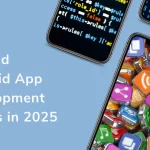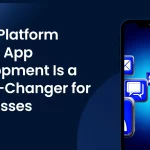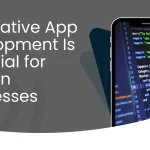A Step-by-Step Guide to Building a Mobile App from Scratch
Building a mobile app from scratch is a rewarding but complex process. Whether you’re a business looking to develop a new app or a developer exploring the world of mobile app development, it’s important to have a clear and structured approach to bring your idea to life. In this guide, we’ll walk you through each phase of the app development lifecycle, from ideation to launch, so you can successfully create an app that meets your goals and delights your users. Building a Mobile App from Scratch.
1. Define Your App Idea and Purpose
The first step in building a mobile app is defining the purpose and target audience. What problem does your app solve? What unique features does it offer? Your app should have a clear, specific function that fulfills a need for your users. Consider the following:
- Problem Identification: Identify the problem your app will solve. This could be anything from a task management tool to a shopping app.
- Target Audience: Define your target users—what are their habits, preferences, and pain points?
- Unique Selling Point (USP): Determine what sets your app apart from competitors. This could be its features, design, or user experience.
2. Conduct Market Research
Before you start building your app, it’s crucial to understand the market. Conduct thorough market research to validate your idea and discover if there’s a demand for it. This can involve:
- Analyzing Competitors: Look at similar apps in the market and identify their strengths and weaknesses. Understand how you can offer something better or different.
- User Feedback: Talk to potential users to gather insights on what they want from an app like yours. Consider surveys, focus groups, or one-on-one interviews.
- Technical Feasibility: Ensure that your app idea is feasible in terms of technology. Will it require advanced features like AI or AR? What platforms (iOS, Android) will it support?
3. Design the App’s User Experience (UX) and User Interface (UI)
Great design is at the heart of every successful mobile app. User experience (UX) and user interface (UI) design ensure your app is both functional and visually appealing. The key stages include:
- Wireframes and Prototypes: Create wireframes to map out the basic layout of your app’s screens and interactions. Tools like Figma or Sketch can help you visualize the app’s structure.
- UI Design: Focus on the app’s visual design—color schemes, typography, and button placement. The design should be consistent, intuitive, and tailored to your target audience.
- User Testing: Once your design is ready, test it with a group of users to ensure it’s easy to navigate and understand. This can involve testing your wireframes or prototypes.
4. Choose the Right Development Approach
Now that your idea and design are solidified, it’s time to decide on the development approach. You have two main options:
- Native Development: Building separate apps for iOS and Android using the respective platform’s programming languages (Swift for iOS, Kotlin or Java for Android). This provides the best performance and access to device features but can be more time-consuming and costly.
- Cross-Platform Development: Developing a single codebase that works across both iOS and Android using frameworks like React Native, Flutter, or Xamarin. This approach can save time and reduce costs but may have some performance limitations.
5. Develop the App
Once you’ve chosen your approach, the development phase begins. This is typically the most time-consuming stage of the process. Key steps include:
- Back-End Development: This involves creating the server-side of your app, which handles data storage, authentication, and communication between the app and databases. You’ll need to set up databases, servers, and APIs.
- Front-End Development: This is where your app’s interface comes to life. Front-end developers write the code that users will interact with—buttons, text fields, and navigation elements.
- Integration: Integrate third-party services like payment gateways, social media logins, or analytics tools to enhance your app’s functionality.

6. Test Your App
Before launching your app, thorough testing is essential to identify bugs, usability issues, and performance problems. Types of testing include:
- Unit Testing: Test individual functions or components of your app to ensure they work correctly.
- Integration Testing: Ensure that different parts of the app (e.g., front-end and back-end) interact as expected.
- User Acceptance Testing (UAT): Involve real users in testing your app to provide feedback on usability, design, and functionality.
- Performance Testing: Check the app’s speed, responsiveness, and ability to handle high traffic loads.
7. Launch the App
After extensive testing and making necessary adjustments, it’s time to launch your app. Here are the key steps for a successful app launch:
- Prepare for Submission: If you’re launching on iOS, submit the app to the Apple App Store. For Android, submit to the Google Play Store. Make sure you have high-quality app screenshots, a compelling app description, and optimized keywords for app store optimization (ASO).
- Marketing: Start building awareness for your app ahead of time by using digital marketing strategies, including social media, email campaigns, and influencer partnerships.
- Monitor and Respond: Once your app is live, monitor its performance and user feedback. Be ready to fix any issues or bugs that arise and respond to user reviews promptly.
8. Maintain and Update the App
The work doesn’t end after launch. Regular maintenance and updates are critical for keeping the app functional and relevant:
- Bug Fixes and Improvements: Address any reported issues and make performance improvements.
- Feature Updates: Release new features or enhance existing ones to keep users engaged and attract new ones.
- Security Updates: Regularly update the app to address any security vulnerabilities, ensuring user data remains protected.
Conclusion
Building a mobile app from scratch is a detailed and multi-step process that requires careful planning, design, development, testing, and maintenance. By following this step-by-step guide, you can navigate the complexities of app development and create an app that meets your business goals and delivers value to your users. Whether you’re a developer or a business owner, understanding each phase of the development lifecycle will set you up for success in the competitive world of mobile apps.









